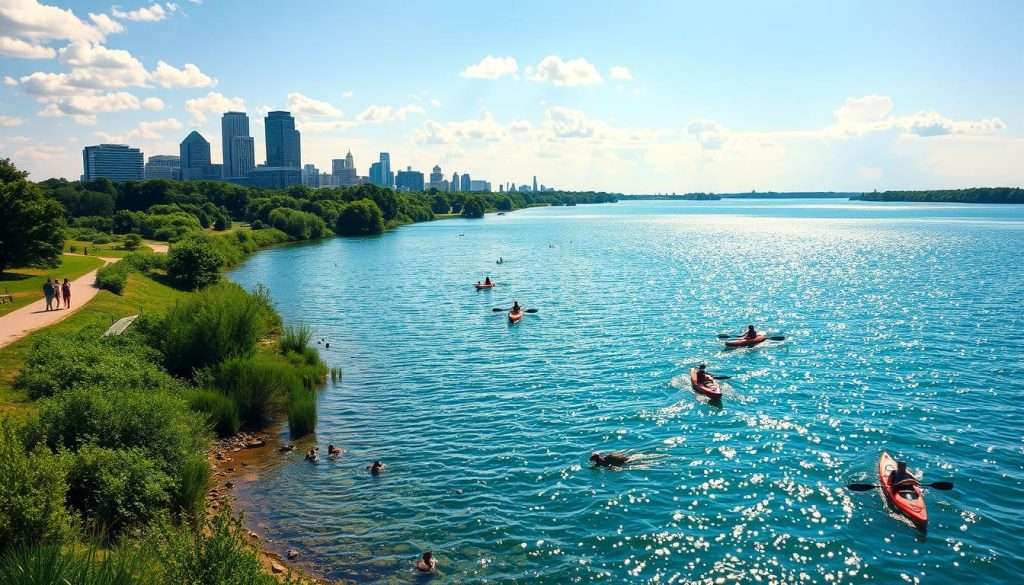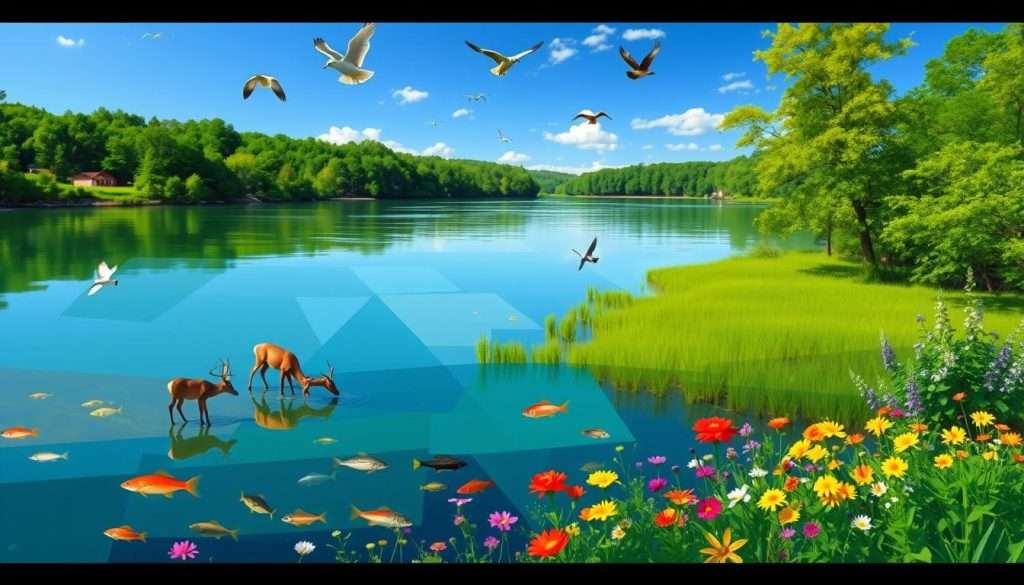Detroit, known as the Motor City, has a beautiful lakeside charm. It’s not right on Lake Michigan, but it has access to Lake Erie and Detroit Lake St. Clair. This makes the waterfront a special place for both locals and visitors.
Exploring Detroit’s lakes shows a lot of fun activities. You can fish, swim, boat, and more. These lakes are more than a break from city life; they’re a big part of Detroit’s identity.
For more on the best lakes for fun and where to rent gear, check out the ultimate guide. It helps you find the perfect spot for a great lakeside adventure in Detroit.
A Brief Introduction to Detroit’s Waterway Wonders
Detroit’s lakes are loved treasures that are key to the city’s health and fun. They cover 4.16 square miles, making them more than just pretty views. They help the local economy and bring people together.
These lakes offer many ways to have fun, making life better for those who live here. They also draw in millions of visitors every year.
The Importance of Lakes in Detroit
Lakes in Detroit are vital for the local wildlife and nature. They clean the water and help the area grow. They also support activities like boating, fishing, and swimming.
These activities make life better and help people connect. They show how important lakes are to the city’s well-being.
History of Detroit’s Lakes
Since Detroit started, lakes have been crucial. They helped with trade and growth. Over time, they became places for parks, beaches, and fun.
Today, lakeside areas are lively with events. They show how lakes have made Detroit a lively and connected place.

| Aspect | Details |
|---|---|
| Area of Water | 4.16 square miles |
| Population (2023) | 633,218 residents |
| Annual Visitors | Approximately 16 million |
| Recreational Activities | Boating, fishing, swimming |
| Historical Significance | Transportation routes and trade |
The Great Lakes and Detroit’s Location
The Great Lakes are a stunning feature of North America. They greatly impact Detroit’s culture, economy, and lifestyle. The lakes, including Lake Superior, Lake Michigan, Lake Huron, Lake Erie, and Lake Ontario, form a natural border. They shape the region’s character.
Understanding these lakes helps us appreciate their role in Detroit’s identity.
An Overview of the Great Lakes
The Great Lakes hold one-fifth of the world’s freshwater. They show millions of years of geological history. They provide resources for transportation, recreation, and tourism.
The lakes offer many experiences, from fishing spots to marinas. They are key to local life. The waterways help move goods and support diverse ecosystems.
Lake Erie: Detroit’s Neighbor
Lake Erie is a key part of the Great Lakes. It borders Detroit to the south. This supports shipping and recreation.
Lake Erie is known for its aquatic life. It attracts fishers and nature lovers. The area around the lake boosts tourism and the economy.
Lake St. Clair: A Hidden Gem
Lake St. Clair is between Lake Huron and the Detroit River. It’s often overlooked but crucial for the area. It offers calm waters and stunning views.
Lake St. Clair is great for boating, kayaking, and fishing. It inspires those seeking a break from the city. It enriches the community’s outdoor lifestyle and biodiversity.
| Lake | Area (sq mi) | Max Depth (ft) | Key Features |
|---|---|---|---|
| Superior | 31,700 | 1,333 | Largest by volume, known for its clear water |
| Michigan | 22,300 | 925 | Only Great Lake entirely within U.S. borders |
| Huron | 23,000 | 750 | Home to many islands, including Manitoulin Island |
| Erie | 9,910 | 210 | Shallowest lake, rich in biodiversity |
| Ontario | 7,340 | 802 | Connects to the St. Lawrence River, vital for shipping |
Fun Facts About Detroit’s Lakes
Detroit’s lakes are more than pretty views. They’re a fun place for everyone. You can try exciting water sports or just enjoy a walk by the water. Belle Isle State Park is full of life, mixing fun with nature.
Lakeside Activities and Attractions
Detroit’s lakes invite you to try new things. You can kayak or relax on the beach. People love to go to parks for picnics, fishing, and walks.
- Kayaking on the Detroit River, offering stunning views of the city skyline.
- Fishing expeditions targeting walleye and other local species.
- Swimming at beaches along Lake St. Clair during hot summer months.
- Bird watching and exploring the Detroit River International Wildlife Refuge, home to over 300 species of birds.
The Detroit River has a rich history. It was once a fur trading route. Now, it’s a place for fun and learning. You can learn about its history and how it’s been made healthy again.
Wildlife and Ecosystems in the Area
The areas around Detroit lakes are full of life. The Detroit River International Wildlife Refuge is a special place. It’s home to many animals, like:
- Bald eagles and various raptors
- Waterfowl like mallards and canvasbacks
- Shorebirds visiting during migration seasons
Doing outdoor activities helps us love nature more. It’s good for us and helps protect the lakes. For more on how to help, visit this informative resource.

The Role of Detroit’s Lakes in Local Culture
Detroit’s lakes are more than just scenery. They are vital to the city’s history and culture. These waters have brought people together for years. They host events that show off the area’s unique charm.
From fishing derbies to music festivals, the lakes are a key part of local life. They are essential to our traditions and how we connect with each other.
Lakes in Detroit’s History and Development
The role of Detroit’s lakes in history is huge. They helped shape the city, guiding trade and attracting settlers. The lakes also influenced how the city was planned and inspired art.
Streets, parks, and community spaces grew around these lakes. They added to the area’s cultural richness.
Community Events and Festivals
Many events on Detroit lakes celebrate the area’s culture. Festivals honor the lakes’ beauty and the community’s diversity. Some big events include:
- Summer Music in the Parks
- Detroit River Days Festival
- Lakeside Fishing Tournaments
- Art on the River Exhibitions
These events are more than fun. They help local businesses and build community. They turn the lakes into lively places where people come together.
Detroit’s lakes are at the heart of the city’s identity. They add to our culture through events and art. Every wave tells a story, keeping our traditions alive and welcoming new ones.
How Detroit’s Lakes Influence Modern Life
Detroit’s lakes are key to the city’s economy and environment. They offer vital resources for businesses, boost tourism, and support fun activities. The boating and fishing industries add about $1.7 billion to the local economy each year.
Studies show that every dollar spent on nature restoration brings six dollars back to the community. This shows that caring for Detroit’s lakes is good for both the planet and the wallet.
Economic Impact of Lakes on Detroit
The health of Lake St. Clair and the Detroit River boosts the local economy. Projects like restoring fish habitats are vital for the fishing industry, worth $4-7 billion yearly. This work is done by local groups, nonprofits, and schools, helping the waters and the community.
Environmental Concerns and Conservation Efforts
The lakes are crucial to Detroit’s economy but face pollution challenges. The Detroit River was named an Area of Concern in 1987. This calls for ongoing restoration, especially at Stony Island and Celeron Island.
Work is underway to create wetlands and bring back species like the marsh wren. This shows Detroit’s dedication to the environment and local wildlife.
Future Outlook for Detroit’s Lakes
The future of Detroit’s lakes is crucial for both the environment and economy. Researchers at Wayne State University are studying water to improve quality and health. This work is part of a growing partnership to restore the lakes.
With careful planning, Detroit’s lakes can stay vital for future generations. This will keep the city’s economy strong and its environment healthy.
